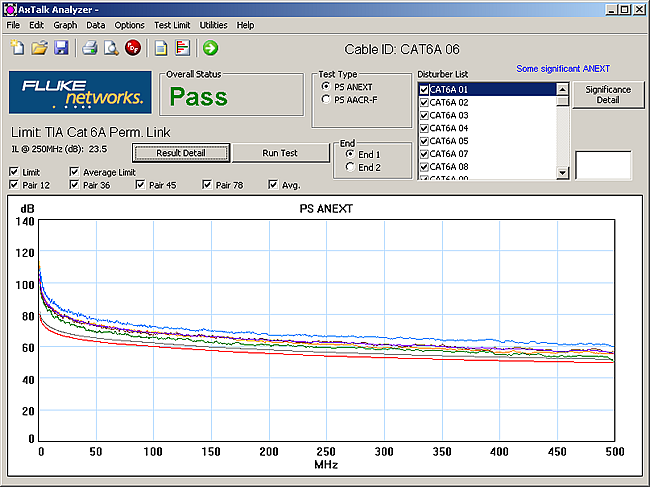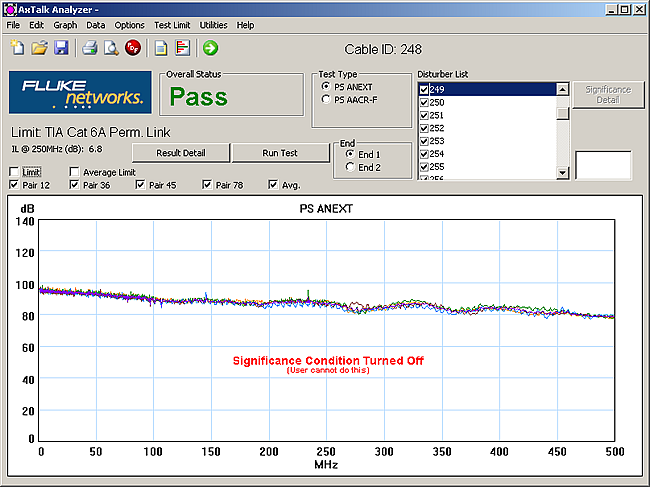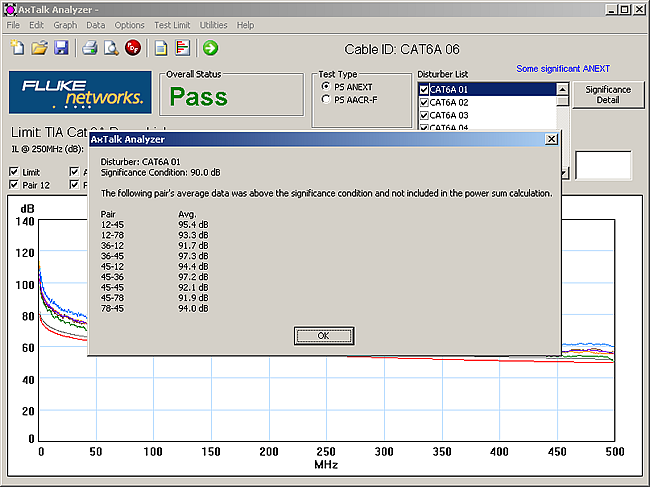Significance detail and significance condition - DTX Alien Crosstalk
From the standards:
The significance condition equals the average frequency response expressed in dB between 100 MHz and 250 MHz. If the average measured ANEXT loss or AFEXT loss between 100 MHz and 250 MHz exceeds the significance condition, then the entire ANEXT loss or AFEXT loss response is excluded (discarded) in the power sum computation. If the average measured ANEXT loss or AFEXT loss between 100 MHz and 250 MHz does not exceed the significance condition, then the entire ANEXT loss or AFEXT loss response is included in the power sum computation. The value of the significance condition is 90 dB.
The purpose of the significance condition is to avoid false failures on large cable bundles, where there are many disturbers (>24). 90 dB is a very small value. On it's own it is insignificant. However, if we were to include these very small values in calculating PS ANEXT or AACR-F on a bundle of 48 cables, they would become significant. If included, it may adversely affect the outcome of the PS ANEXT or AACR-F result.
Below is an example PS ANEXT result on a bundle of 48 cables with the significance condition turned on. It PASSes.

Now look and see what happens when we turn of the significance condition - the result is a FAIL.

The user is not able to turn on/off the significance condition. It is always on as required by the cabling standards.
If you have a perfectly screened cabling system, it is possible that ALL of your ANEXT and AFEXT measurements are above the significance condition. When that happens, the AxTalk Analyzer will present the user with a blank graph.
From the AxTalk Analyzer user interface, you can quickly assess the impact an individual disturber has on the overall power sum alien crosstalk result. Select a disturber from the Disturber List to view its significance assessment. One of three messages is displayed:
-
“No significant ANEXT” or “No significant AFEXT”. None of the selected pair’s average data was below the significance condition. The power sum result of the disturbed link does not add any alien crosstalk data from the selected disturbing link. All pair-to-pair alien crosstalk results were considered random data. This suggests that the selected disturber link does not affect the alien crosstalk of the disturbed link at all.
-
“Some significant ANEXT” or “Some significant AFEXT.” Some of the selected pair’s average data was below the significance condition and included in the power sum calculation. The power sum result of the disturbed link does contain alien crosstalk data caused by the selected disturbing link from some of the pair combinations only. The pair-to-pair alien crosstalk results of other pair combinations were considered random signals. This suggests that the selected disturber link has only minimal impact on the alien crosstalk of the disturbed link.
- “All significant ANEXT” or “All significant AFEXT.” The power sum result of the disturbed link does contain alien crosstalk data from all pair combinations of the selected disturbing link. None of the pair-to-pair alien crosstalk results were considered random data. This suggests that the selected disturber link significantly influences the alien crosstalk of the disturbed link.
You can click Significance Detail to view more information about the significance condition for the disturber link. The significance threshold is 90.0 dB. An example is given below:





